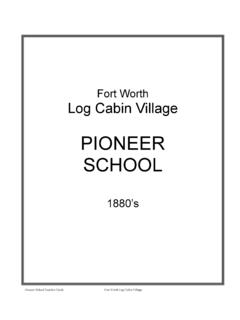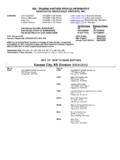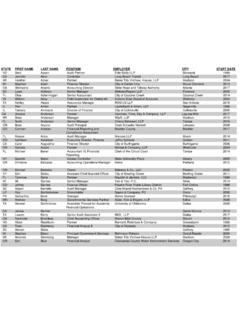Transcription of Pioneer School Curriculum 2013 kp revisions - Fort Worth's ...
1 Pioneer School 1880s Log Cabin Village Pioneer School Teacher's Guide 3rd - 4th Grades (may be appropriate for other grades) Assembled with the assistance of: Heritage Village School , Lincoln Nebraska Diane Winans, Eagle Mountain Elementary Shelly Couch, Saginaw Elementary Log Cabin Village Staff 1995 (Updated 2013) OVERVIEW OF Pioneer School PROGRAM This program is designed to allow you, the teacher, to help your class step back 100 years and experience a School day in the late 1800s.
2 Pioneer School can be an important lesson for our twenty-first century children. W e hope to help you make it as authentic as possible. We have gathered together facts, fiction and fun to help you create a wonderful learning adventure. Please adapt this information, ideas and activities to your individual teaching style. Many of the games, songs and rules should be introduced to your class before your visit. Feel free to do your own research. When you and your class arrive at the Village, you will be ushered to the School house and familiarized with the grounds and facilities.
3 It is up to you from that point on, to conduct class, 1800s style. Village staff members are readily available if problems or questions arise. RATIONALE Children have varying concepts of what life was like over a 100 years ago. The first process is to assess their knowledge and feelings about a one-room School . Then, through group discussions and the materials in this booklet, students can learn about the family life of a typical Pioneer child as well as their songs and games. During their participation in a fairly authentic day in a one-room School , the children will observe and experience what being a student was like in the 1800s.
4 Back in your own 21st century classroom, the students can share thoughts and feelings, compare past with present and explore ideas about schools of the future. Pioneer School SCHEDULE (Typical Day) Feel free to adjust subjects and time studied to your teaching style. This is just a suggested order of subjects and allocation of time. Penmanship (15 minutes) Reading aloud (15 minutes) Geography (15 minutes) Break (15 minutes) Arithmetic (30 minutes) Recitation (30 minutes) Lunch (30 min.) Recess (historic games & songs) or Spelling Bee (30 minutes) *Your Meet the Pioneers tour time will start at either 9:30 (if touring first) or 12:30 (if touring second) Important Instructions Please help us preserve our historic schoolhouse by following the rules below: Leave the schoolhouse as you found it (straighten benches, clean up trash, chalk, erase the chalkboard, and sweep the floor if necessary).
5 DO NOT WRITE ON THE WALLS WITH THE CHALK! Lunch must be eaten outside of the Village grounds and across the street at Bobo Woods unless the weather does not permit outdoor activities. Because the floorboards in the School are over one hundred years old, no water or other liquids will be permitted inside. Please report any damages to the front desk (broken slates, benches, etc.). Since there will be other museum visitors during your stay, please ensure that noise level is kept under control. No running or climbing is allowed throughout the entire Village, and everyone must stay on the asphalt pathways.
6 Students should not be left or allowed to roam unattended. Thank you!! INTRODUCTION TO Pioneer SCHOOLS Texas settlers were interested in providing a good basic education for their children, boys and girls alike. Home schooling was the rule until several pioneers settled in the same area. They then banded together to provide or build a School house and hire a School - master from the East. The local families shared the cost of the teacher's salary, which might be paid in food, clothing or land. THE School HOUSE The School house was commonly a one room building where all ages and grades levels were taught together.
7 As the community grew in size, separate classes were created for different age levels. Schools were often built on land that was not suitable for farming or other productive use. Dirt floors were not uncommon in early schools, and desks and benches consisted of rough plank furniture. The first buildings had fireplaces, but by the mid-1800s wood stoves were common. Chalk boards were made by painting a smooth board black. The School yard usually contained "privies" (outhouses) and a flat area for playing games. Water came from a well or nearby creek.
8 There was usually a bucket and dipper near the door that provided drinking and washing water. The School house also served other community functions. Social and holiday gatherings were the highlight of each year. The building was the site of box socials, community spelling bees and seasonal activities. TEACHERS Qualified teachers were prized in the community. Until one could be hired, a parent of one of the children might take on the duties. Until the late 1800s, male teachers were predominant. Teacher salaries were typically low ($15 - $30 per month).
9 Many young women entered the teaching field because salary was not the issue - starting a career was. Rural teachers often began at the age of 16. Teachers were expected be virtuous and have extremely high morals (see Teacher Rules). They were also expected to keep the School house clean, draw each day's water supply and keep the wood stove fired up on cold days. The community would provide the fuel for the fires. School SUPPLIES Most students had to furnish their own supplies, including books, writing slates and chalk.
10 Children were asked to bring whatever books were at home, which generally meant a Bible, an almanac or old textbooks brought on the westward trip. School DAYS The School term was constructed around the needs of the community. The farm family needed all available hands for spring planting and fall harvest, therefore School was not held during this time period. Most rural children attended shorter sessions than city children. The nine month School term was fashioned for urban communities. A typical School day would begin with a patriotic song, a salute to the flag and possibly a scripture reading or prayer.




